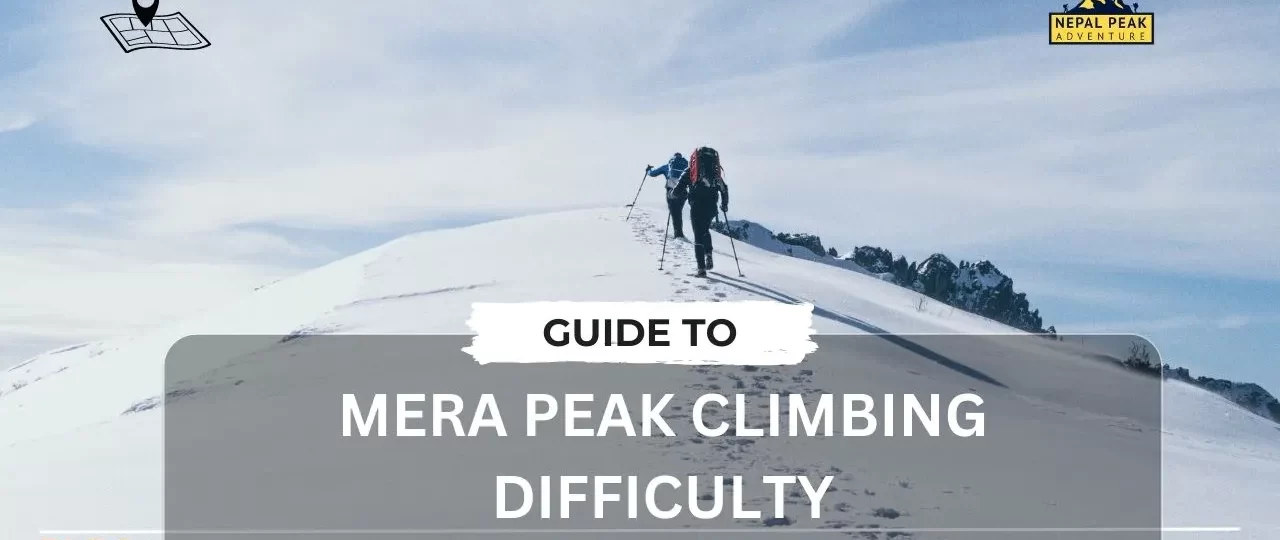Mera Peak Difficulty: Unveiling the Challenges and Triumphs
Mera Peak, located in the beautiful Khumbu region of Nepal in the Northeast, is a mountain that has captured the attention and admiration of mountaineering enthusiasts from around the world. Rising to an impressive height of 6,461 meters (21197.51 feet), Mera Peak Central is one of the best peaks to try your climbing skills. However, as beautiful as Mera Peak is, climbing the Mera Summit also shares and possesses its fair share of difficulties and challenges with an alpine grade of PD.
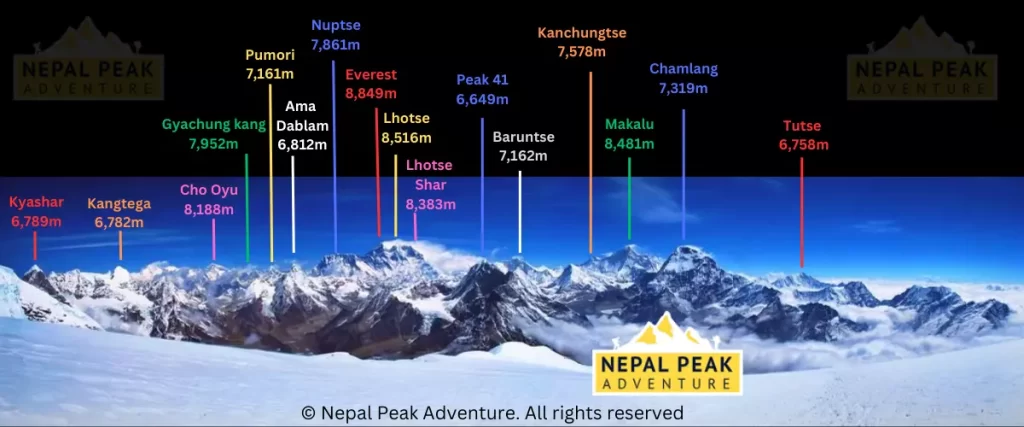
Truthfully, Mera Peak is not for the faint of heart. It demands a combination of physical prowess, mental resilience, and technical skills to conquer its majestic heights. The journey to the summit is filled with obstacles and obstacles that test climbers in various ways. Steep technical climb, glaciers, weather, 50° snow dome Ascent in the final section, Jumaring on short steep snow, and other factors make it interesting and thrilling at the same time.
To climb this peak successfully, you need to understand the various factors that contribute to the difficulty of scaling this impressive peak. In this blog, we will delve into the intricacies of Mera Peak’s difficulty, exploring the various factors that contribute to its formidable nature and the challenges that mountaineers must overcome.
Table of Contents
Quick Facts About Mera Peak:
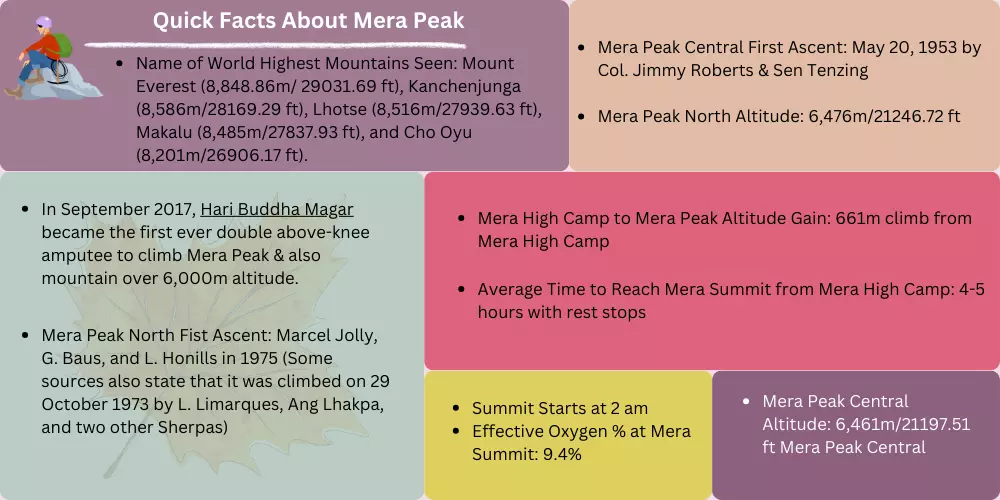
“Mera Peak is considered as the highest trekking peak in Nepal.”
- Mera Peak Central Altitude: 6,461m/21197.51 ft Mera Peak Central
- Mera Peak Central First Ascent: May 20, 1953 by Col. Jimmy Roberts & Sen Tenzing
- Mera Peak North Altitude: 6,476m/21246.72 ft
- Mera Peak North Fist Ascent: Marcel Jolly, G. Baus, and L. Honills in 1975 (Some sources also state that it was climbed on 29 October 1973 by L. Limarques, Ang Lhakpa, and two other Sherpas)
- In September 2017, Hari Buddha Magar became the first ever double above-knee amputee to climb Mera Peak & also mountain over 6,000m altitude.
- Mera High Camp to Mera Peak Altitude Gain: 661m climb from Mera High Camp
- Average Time to Reach Mera Summit from Mera High Camp: 4-5 hours with rest stops
- Summit Starts at 2 am
- Effective Oxygen % at Mera Summit: 9.4%
- Name of World Highest Mountains Seen: Mount Everest (8,848.86m/ 29031.69 ft), Kanchenjunga (8,586m/28169.29 ft), Lhotse (8,516m/27939.63 ft), Makalu (8,485m/27837.93 ft), and Cho Oyu (8,201m/26906.17 ft).
Classifying the Difficulty Level of Mera Peak:
Based on the International French Adjectival System (IFAS) for classifying climbing difficulties, Mera Peak is generally considered to fall within the F (Facile) or PD (Peu Difficile) category. This means it is a moderately difficult climb that requires basic mountaineering skills, such as the use of crampons and ice axes, along with an understanding of rope work and glacier travel.
Actually, factors like long-day trekking, itinerary, weather, altitude, accommodation, and other absence of proper facilities also make peak climbing difficult.
So first let’s delve into the itinerary of Mera Peak with its difficulty level:
Note: Day 1 is arrival day & Day 2 is preparation day which is why we will not mention their difficulty level.
Day 3: Flight to Lukla & Trek to Paiya/Puiya
Distance: Approximately 10 km (6.2 miles)
Average Duration: 5-6 hours Lukla to Paiya – 15 minutes flight from Ramechhap to Lukla or 30 minutes from Kathmandu to Lukla
Difficulty Level: Easy
Altitude: 2,730 m/8,956.6 ft
Day 4: Paiya to Panggom Trek
Distance: Approximately 10 km (6.2 miles)
Average Duration: 5-6 hours Trek
Difficulty Level: Easy
Altitude: 2846 m/9,337.2 ft
Day 5: Trek to Ningsow
Distance: Approximately 5 km (3.1 miles)
Average Trek Duration: 5-6 Hours
Altitude Level: 2,863m/9,393.04 ft
Difficulty Level: Easy
Day 6: Trek to Chhatra Khola
Distance: Approximately 8km (4.9miles)
Average Duration: 6 Hours
Difficulty Level: Easy
Altitude Level: 2800m/9,186 ft
Day 7: Trek to Kothe
Distance: Approximately 7 km (4.3 miles)
Average Duration: 5-6 hours
Difficulty Level: Moderate
Altitude Level: 3,691m/ 12,109.58 ft
Day 8: Trek to Thagnak
Distance: Approximately 8 km (4.9 miles)
Average Duration: 4-5 Hour
Difficulty Level: Moderate
Altitude: 4,358m/14,297.9 ft
Day 9: Trek to Khare
Distance: 5km (3.1 miles)
Average Duration: 4-5 hours
Difficulty Level: Moderate
Altitude: 5,045m/16,551 ft
Day 10: Acclimatization & Pre-Climbing Training
Acclimatization Day is the best way to adapt to the high altitude and prepare for the next day. It is compulsory in high-altitude trekking or peak climbing activities.
Day 11: Trek to Mera High Camp
Distance: Approximately 4km (2.4 miles)
Average Duration: 3-4 hours
Difficulty Level: Challenging
Altitude: 5,780m/18,963.2 ft
Day 12: Climb to Mera Peak Central 6,461m and return to Khare
Distance: Approximately 8km round trip (4.9 miles)
Average Duration: 7-8 hours
Difficulty Level: Challenging
Altitude: 6,461m/21,197.5 ft
Day 13: Reserve Day for Contingency
Day 14: Trek to Kothe
Distance: Approximately 13km (8.07 miles)
Average Duration: 5-6 hours
Difficulty Level: Challenging
Altitude: 3,600m/11,811.02 ft
Day 15: Trek to Thuli Kharka
Distance: Approximately 8 km (4.9 miles)
Average Duration: 5-6 hours
Difficulty Level: Moderate
Altitude: 4,300m/14,107.61 ft
Day 16: Trek to Lukla
Distance: Approximately 11.4 km (7.11 miles)
Average Duration: 5-6 hours
Difficulty Level: Moderate
Altitude: 2,642m/8,667.9 ft
This is one of the popular routes for Mera Peak Climb that we sell on our website. As you can see, there are only a few challenging levels according to the itinerary. Most of the routes are either moderate level or easy level for trekkers & climbers.
In general, the whole trip covers around 78-80 miles including rugged & remote terrains, glaciers, crevasses, icicles, etc. Moreover, there are other factors that can make even an easy trail to a difficult one. So, let’s see what the major factors of Mera Peak Climbing Difficulty are.
Factors of Mera Peak Difficulty & Safety Measures
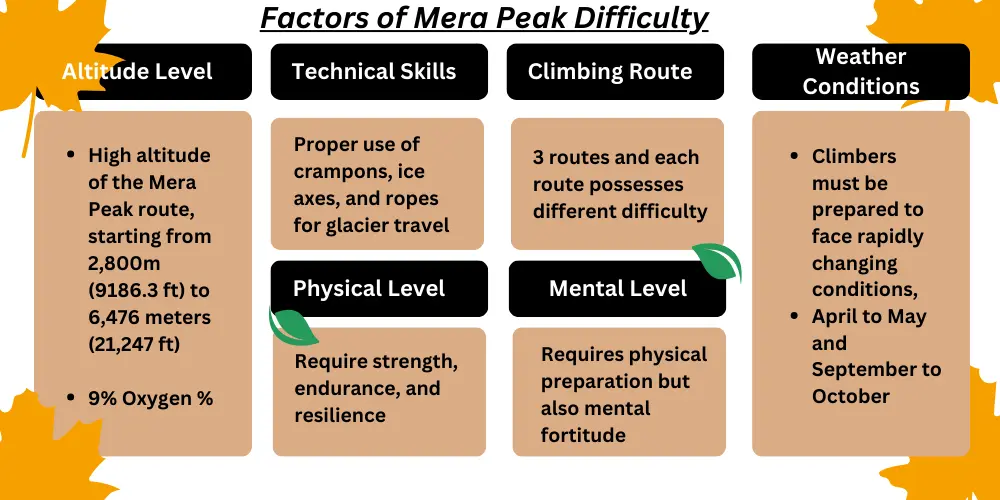
While it is considered a relatively achievable climb for those with basic mountaineering skills and experience, several factors contribute to the overall difficulty of ascending Mera Peak:
Altitude: 9% Effective Oxygen
The high altitude of the Mera Peak route, starting from 2,800m (9186.3 ft) to 6,476 meters (21,247 ft), poses a significant challenge. During the Mera peak summit, the low oxygen level approximately 9% makes the climb potentially fatal.
Similarly, let’s not forget the AMS, HACE, & HAPS that can usually happen at levels above 2,500m. Among 10 climbers, 1 climber has a chance to get altitude sickness during the trip. However, there are safety measures that you can apply to make altitude sickness less effective.
How to prevent high altitude sickness?
The first thing to do is descend from your location to a lower elevation when you suffer from high altitude sickness. Similarly, climbers need to acclimatize properly during the trip and should drink enough fluid too.
Technical Terrain needs Technical Skills:
While Mera Peak does not demand advanced technical climbing skills, climbers still need to be familiar with basic mountaineering techniques for the Mera Peak summit. This includes the proper use of crampons, ice axes, and ropes for glacier travel, as well as understanding crevasse rescue techniques. Proper fitting, adjustment, and secure attachment are also crucial.
Safety Measures:
Climbers should be well-versed in various ice axe techniques, from self-arrest to the proper use for ascending and descending icy slopes. The gears should be well-checked and should be comfortable for you.
Climbing Route for Mera Peak:
There are 3 routes to reach Mera Peak and each route possesses different difficulty levels according to the itinerary. The shorter the itinerary the more difficult it gets in Mera Peak climb. Let’s delve into each route individually:
Mera Peak via Zatrawa La Pass (Photo): Route 1
The route from Zatrawa La Pass to Mera Peak is one of the shortest and most challenging routes to do Mera Peak Climb in Neal. On this route, you will have 1 acclimatization day, and 1 extra day in case of bad weather, and you can view lots of charming villages during your trip.
This route is best for intermediate-level climbers as it can take 17 Days to complete on average.
Here is an outline itinerary for Mera Peak via Zatrawa La Pass & its difficulty level.
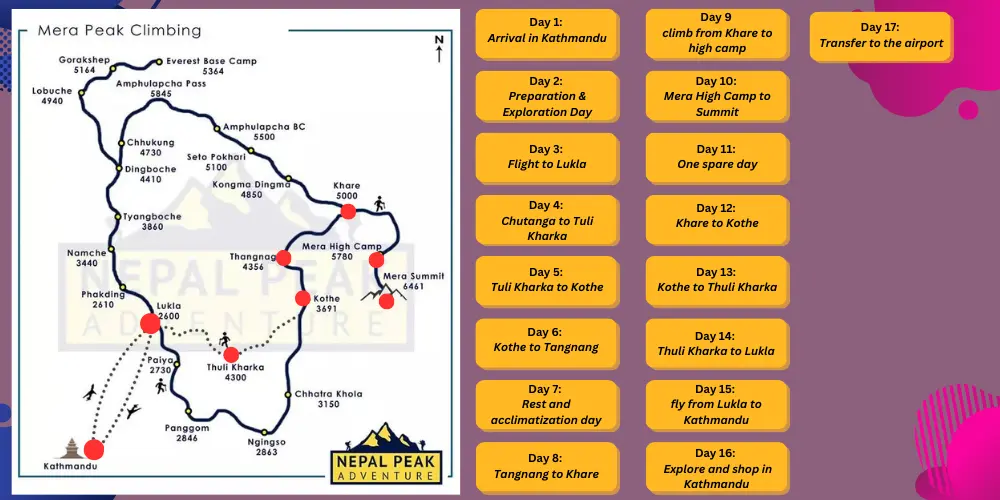
Day 1: Arrival at Kathmandu Airport, Transfer to the hotel (1350M/4,430ft)
Day 2: Trek Preparation & Exploration Day in Kathmandu.
Day 3: Flight from Kathmandu to Lukla (2800m) & trek to Chutanga (3050m) which take about 4 hours.
Day 4: Trek from Chutanga to Tuli Kharka (Chatra-La) (3900m) which takes about 6 hours. You trek via Zatrawa La Pass (4610m) and downclimb to Khartitang at 3900m.
Day 5: Trek from Tuli Kharka to Kothe (4095m) – 5hrs.
Day 6: Trek from Kothe to Tangnang (4,350m) – 5hrs. Enjoy the fantastic view of the south face of Mera Peak throughout the day
Day 7: Rest and acclimatization day at Thangnak. Visit Sabal Tsho Lake and take an acclimatization hike to the cairn (5271m) on the flank of Kusum Kangguru (6367m).
Day 8: Trek from Tangnang to Khare (5,045m) – takes about three and a half hours.
Day 9: Trek and climb from Khare to high camp (5,780m) – 4-5hrs.
Day 10: Summit Day; Mera High Camp to Summit (6,654m) and return to Khare.
Day 11: One spare day in case of bad weather during the summit day.
Day 12: Trek from Khare to Kothe (3600m) – 5hrs.
Day 13: Trek from Kothe to Thuli Kharka – takes about six hours.
Day 14: Thuli Kharka to Lukla: via Zatrwa La pass. This is the last evening in the mountains, the ideal opportunity for a farewell party with our staff.
Day 15: Early in the morning, fly from Lukla to Kathmandu, which takes about 35 minutes. Transfer to hotel. Leisure and shopping day in Kathmandu.
Day 16: Explore and shop in Kathmandu. Farewell-Celebration dinner with cultural programming in the evening.
Day 17: Transfer to the airport for the final departure
Difficulty Level: Very Challenging
Best For: Intermediate climbers to Experienced Climbers
Mera Peak Route 2: 18 Days
This route is very famous among climbers as the itinerary is well-made making it a little easier for new climbers. The route starts from the Lukla flight & into the charming villages of Paiya, Ningsow, & Chhatra Khola. Here is the outline itinerary of this second route:
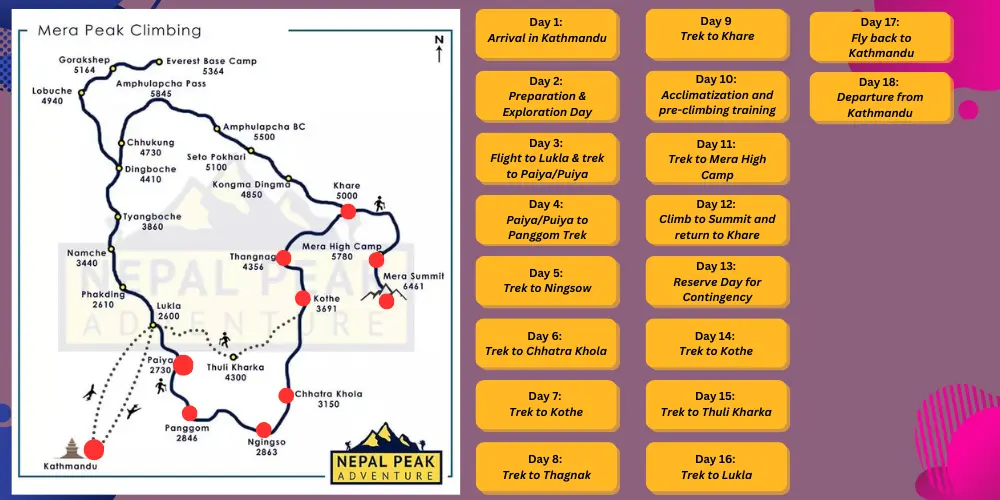
Day 01: Arrival in Kathmandu Airport & Transfer to Your Hotel(1400m)
Day 02: Sightseeing inside Kathmandu Valley and preparing for the trek & climb (1400m)
Day 03: Flight from Kathmandu/Ramechhap to Lukla (2860m) and trek to Paiya/Puiya (2730m)
Day 04: Paiya/Puiya to Panggom Trek (2846m)
Day 05: Trek to Ningsow (2863m)
Day 06: Trek to Chhatra Khola (2800m)
Day 07: Trek to Kothe (3691m)
Day 08: Trek to Thagnak (4358m)
Day 09: Trek to Khare (5045m)
Day 10: Acclimatization and pre-climbing training
Day 11: Trek to Mera High Camp (5780m)
Day 12: Climb to Summit (6461m) and return to Khare (5045m)
Day 13: Reserve Day for Contingency
Day 14: Trek to Kothe (3600m)
Day 15: Trek to Thuli Kharka (4300 m)
Day 16: Trek to Lukla (2642m)
Day 17: Fly back to Kathmandu (1400m)
Day 18: Departure from Kathmandu
Difficulty Level: Challenging
Best for: Beginner level plus
Mera Peak via Paphlu: Route 3
Same as the second route but instead of a flight to Lukla, you will drive to Paphlu via vehicle on the road in this itinerary. You will visit some charming villages along the way (Nunthala, Bupsa, & Pangkoma). Here is the outline itinerary of this route:
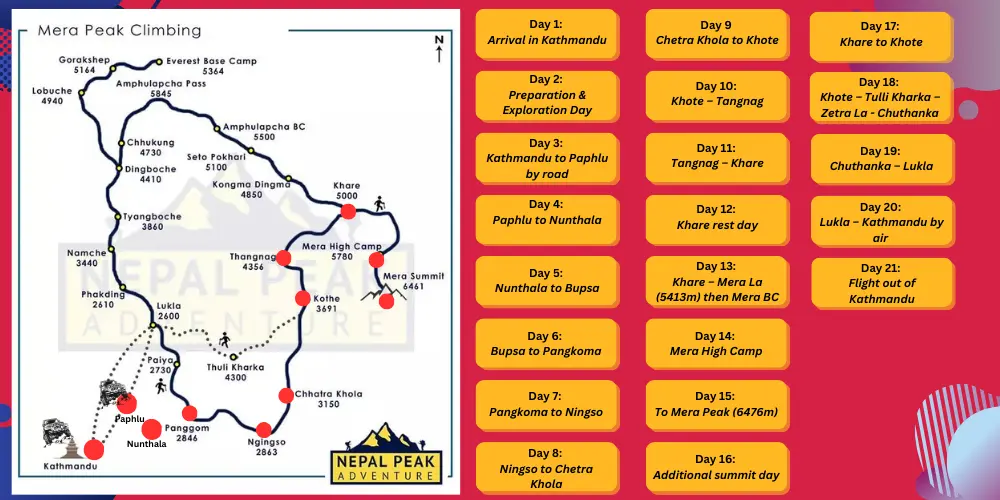
Day 01: Arrive in Kathmandu, transfer to hotel
Day 02: Rest day in Kathmandu
Day 03: Kathmandu to Paphlu by road – 8 hrs
Day 04: Paphlu to Nunthala
Day 05: Nunthala to Bupsa
Day 06: Bupsa to Pangkoma
Day 07: Pangkoma to Ningso
Day 08: Ningso to Chetra Khola
Day 09: Chetra Khola to Khote
Day 10: Khote – Tangnag
Day 11: Tangnag – Khare
Day 12: Khare rest day
Day 13: Khare – Mera La (5413m) then Mera BC
Day 14: Mera High Camp
Day 15: To Mera Peak (6476m)
Day 16: Additional summit day
Day 17: Khare to Khote
Day 18: Khote – Tulli Kharka – Zetra La (4610m) – Chuthanka
Day 19: Chuthanka – Lukla
Day 20: Lukla – Kathmandu by air and back to the hotel.
Day 21: Flight out of Kathmandu
Difficulty Level: Challenging
Best for: All levels
In conclusion, the route to Mera Peak is also a major factor in Mera Peak’s difficulty.
Weather Conditions
The Khumbu region, where Mera Peak is located, experiences unpredictable weather patterns. Climbers must be prepared to face rapidly changing conditions, including snowstorms, blizzards, and high winds. Choosing the right climbing season, typically April to May and September to October, helps mitigate the risks associated with adverse weather.
Safety Measures:
Equip yourself with suitable gear for various weather scenarios. This includes waterproof clothing, insulated layers, and gear designed to withstand cold, wind, and precipitation. Carry reliable communication devices, such as a satellite phone or emergency beacon, to stay in touch with the outside world in case of emergencies.
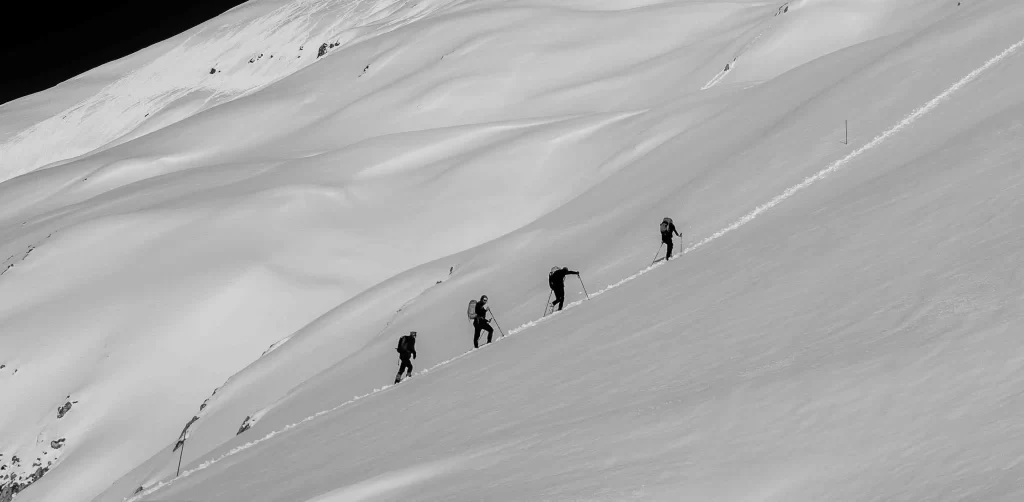
The Two Summits of Mera Peak: Central & North
Generally, Mera Peak has three main summits: Mera North 6,476m/ 21,246.7 ft, Mera Central 6,461m/ 21197.51 ft & Mera South 6,065m/ 19898.29 ft. However, only two summit Mera Peak Central and Mera Peak North is classified by the Nepal Mountaineering Association. Among these two, Mera Peak Central is the most popular summit among climbers.
When summiting the Mera Central, the last 30-meter climb requires a lot of effort including Jumaring on a steep snow section. It takes about 5 to 6 hours to reach the summit.
Following that, towards the end of the steeper terrain, we see the central summit rising above a wide glacier, with two ridges on either side. We carefully navigate the snowfields, avoiding crevasses. This part can be slow, taking about 2 hours.
After getting through the steep section, the route turns east of the left-hand ridge before looping back towards the main summit ridge of Mera. This is a critical phase of the climb.
In simple terms, reaching the summit involves starting early, pacing ourselves, navigating challenging terrain, and putting in a final push for the top. The weather plays a crucial role, and careful planning and technique are key to a successful climb of Mera Peak.
What you should do to Climb Mera Peak?
If you’ve conquered the Everest base camp trek or triumphed over Kilimanjaro, consider yourself well-prepared for the Mera Peak ascent. While Mera Peak doesn’t demand advanced technical climbing, having a high-altitude trek under your belt provides a solid foundation.
Surprisingly, at Khare before the actual summit day, most guide offers a climbing course that is very easy to learn and easy to apply.
Remember, Mera Peak is a trekking peak which is why a few weeks of training & course on mountaineering skills is enough for you. However, you should not neglect the preparation for high altitude trek.
Have a good physical level and experience in trekking before heading to Mera Peak.
Physical Challenges on Mera Peak
The ascent of Mera Peak presents climbers with a range of physical challenges that require strength, endurance, and resilience. The arduous journey to the summit involves trekking through rugged terrain, crossing crevassed glaciers, and navigating steep slopes. The high altitude adds an extra layer of difficulty, as the thin air and reduced oxygen levels demand careful acclimatization and can lead to altitude-related illnesses.
Climbers must be prepared for long days of trekking, carrying heavy backpacks, and facing unpredictable weather conditions, including snowstorms and high winds. The physical demands of Mera Peak ascent necessitate excellent cardiovascular fitness, muscular strength in the legs and core, and the ability to endure prolonged physical exertion.
Training programs should focus on building endurance through activities such as hiking, running, and stair climbing, as well as strength training exercises targeting the lower body and upper body for carrying loads. Proper acclimatization, hydration, and nutrition are vital to sustain energy levels and mitigate the risk of altitude sickness. By adequately preparing for the physical challenges of Mera Peak, climbers can reduce the Mera Peak difficulty increase their chances of a successful summit, and fully embrace the awe-inspiring experience that awaits them.
Mental Challenges on Mera Peak Difficulty
Embarking on the ascent of Mera Peak not only requires physical preparation but also mental fortitude to overcome the numerous mental challenges that climbers may encounter along the way. The isolation, harsh conditions, fear, and the prolonged nature of the climb can all take a toll on one’s mental state. However, with the right strategies and mindset, climbers can navigate these challenges and maintain their motivation to reach the summit.
Coping with Isolation and Harsh Conditions
Mera Peak is located in a remote and isolated region, far from the comforts of civilization. The long trekking days, primitive conditions, and the absence of familiar surroundings can lead to feelings of isolation and loneliness. To cope with these challenges, it is crucial to stay connected with your climbing team and establish a support system. Sharing experiences, thoughts, and emotions with fellow climbers can provide a sense of camaraderie and alleviate feelings of isolation. Additionally, keeping in touch with loved ones back home through satellite phones or messaging can provide a source of comfort and motivation. Furthermore, embracing the rugged beauty of the surroundings and immersing oneself in the natural environment can help alleviate the sense of isolation.
Overcoming Fear and Maintaining Motivation
Fear is a natural response when facing challenging situations, and climbing Mera Peak is no exception. Exposure to heights, steep slopes, and unpredictable weather conditions can trigger fear and doubts. To overcome fear, it is essential to focus on building self-confidence through proper training, preparation, and gaining knowledge about the route and climbing techniques.
Visualizing success and setting small goals along the way can help maintain motivation and break down the climb into manageable sections. Celebrate each milestone achieved, such as reaching a base camp or completing a challenging section. Support from fellow climbers and experienced guides can also be invaluable in maintaining motivation. Surrounding yourself with a positive and encouraging team creates a supportive environment where you can uplift and motivate each other during challenging moments.
By implementing these strategies and cultivating a resilient mindset, climbers can effectively reach the summit of Mera Peak. Remember that conquering the mental game is just as important as conquering the physical obstacles, ultimately leading to a more fulfilling and successful climb.
Physical and Mental Conditioning
Physical fitness plays a vital role in tackling the challenges of Mera Peak. The ascent demands endurance, strength, and agility to navigate through varied terrain and withstand the physical demands of high-altitude climbing. Prior to your expedition, engage in a well-rounded training program that incorporates cardiovascular exercises, strength training, and flexibility exercises.
Cardiovascular exercises, such as running, cycling, or swimming, improve your endurance and enhance your cardiovascular health. These activities simulate the demands of long days of trekking and climbing, preparing your body for the sustained effort required during the ascent. Incorporate weightlifting, bodyweight exercises, or functional training to build muscular strength and endurance. Strengthening your muscles will support your body during arduous climbs, aid in carrying your gear, and reduce the risk of injuries.
In addition to physical conditioning, mental preparation is crucial for a successful ascent. Climbing Mera Peak requires mental fortitude, determination, and the ability to cope with challenging situations. Engage in activities that enhance your mental resilience, such as meditation, visualization, or mindfulness exercises. Practice managing stress and maintaining a positive mindset to overcome obstacles during the climb.
Acclimatization and Altitude Sickness Prevention
Mera Peak altitude 6,476m, presents one of the greatest challenges for climbers. Adequate acclimatization is essential to adapt your body to reduced oxygen levels and minimize the risk of altitude sickness. Ascending gradually allows your body to adjust and build red blood cells, which aid in oxygen transport.
Follow established Mera climbing itineraries that incorporate rest days at specific elevations to facilitate acclimatization. During these rest days, take the opportunity to explore the surroundings, engage in light activities, and allow your body to adjust to the altitude. It is crucial not to rush the ascent and prioritize the well-being of your body overreaching the summit quickly.
Altitude sickness, particularly acute mountain sickness (AMS), is a potential risk when climbing Mera Peak. To prevent AMS, it is important to stay hydrated by drinking plenty of fluids, preferably water. Avoid excessive physical exertion during the early stages of the climb and maintain a slow and steady pace to allow your body to adapt gradually.
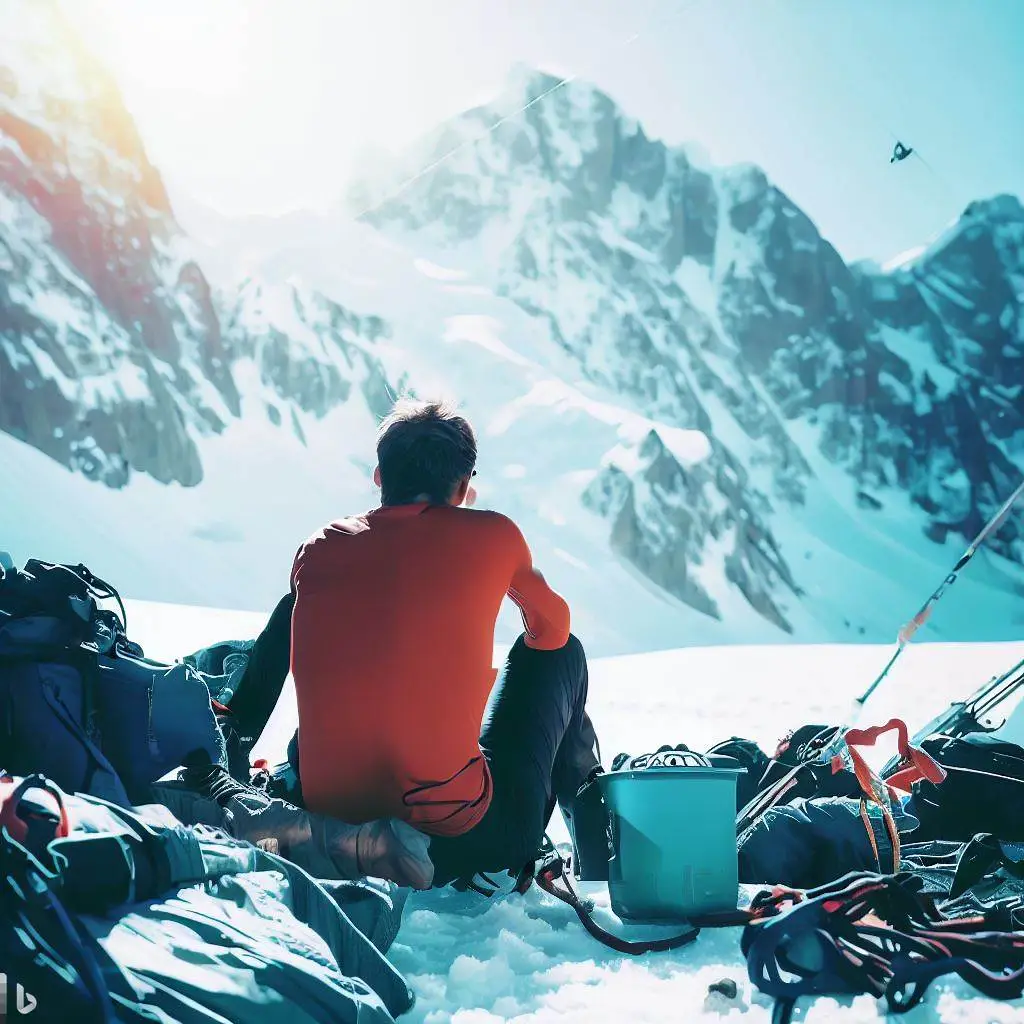
FAQs regarding the Mera Peak Difficulties
Is prior mountaineering experience necessary to climb Mera Peak?
While prior mountaineering experience is not mandatory, it is highly recommended. Mera Peak presents various challenges, including technical sections, high altitude, and demanding terrain. Having previous mountaineering experience will provide you with the necessary skills and knowledge to navigate these challenges safely.
How long does it take to climb Mera Peak?
The duration of the Mera Peak climb varies depending on factors such as fitness level, acclimatization, and weather conditions. On average, the expedition takes around 18-20 days, including trekking to and from Lukla, acclimatization days, and the climb itself. It is important to allocate sufficient time for acclimatization to minimize the risk of altitude sickness and ensure a safe and enjoyable experience.
Is climbing Mera Peak dangerous?
Climbing any mountain carries inherent risks, and Mera Peak is no exception. It involves exposure to high altitude, technical sections, and unpredictable weather conditions. However, with proper preparation, training, and guidance from experienced climbers or mountaineering agencies, the risks can be minimized. It is essential to prioritize safety, follow expert advice, and make informed decisions throughout the expedition.
Do I need special permits to climb Mera Peak?
Yes, climbers need to obtain permits to climb Mera Peak. These include the Sagarmatha National Park Entry Permit and the Mera Peak Climbing Permit. Don’t worry, we do manage and provide you with all the permits and necessary documents for the climb.
Conclusion
The rewards of conquering Mera Peak are abundant. Standing atop its majestic summit brings a sense of achievement and awe-inspiring views of the Himalayan landscapes. So, dear reader, if you are inspired by the allure of Mera Peak and the rewards it holds, it is time to embark on your own adventure. Prepare yourself physically and mentally, acquire the necessary skills and knowledge, and surround yourself with a supportive team. Embrace the challenges, overcome the obstacles, and let the spirit of adventure guide you to new heights.
We Nepal Peak Adventure Team is all ready to ensure your safe Mera Peak Climbing and make a lifetime achievement.
